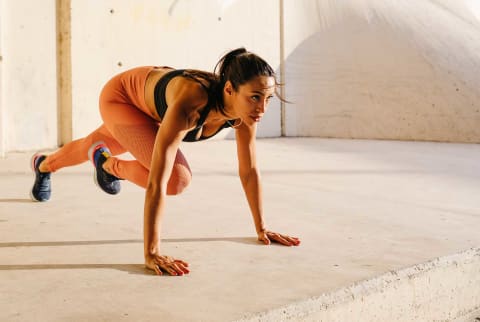Advertisement
This ad is displayed using third party content and we do not control its accessibility features.

Beauty & Health Editor
Beauty & Health Editor
Hannah Frye is the Beauty & Health Editor at mindbodygreen. She has a B.S. in journalism and a minor in women’s, gender, and queer studies from California Polytechnic State University, San Luis Obispo. Hannah has written across lifestyle sections including beauty, women’s health, mental health, sustainability, social media trends, and more. She previously worked for Almost 30, a top-rated health and wellness podcast. In her current role, Hannah reports on the latest beauty trends and innovations, women’s health research, brain health news, and plenty more.

Image by Stocksy | Javier Díez
July 31, 2024
More and more people are talking about VO2 max—and we’re here for it. On a recent episode of the mindbodygreen podcast, performance coach and scientist Andy Galpin, Ph.D., delivered an in-depth crash course on this important longevity metric, which I highly recommend you listen to.
If you don’t have time to tune in just yet, keep reading. We’ll outline how to support your VO2 max starting today, directly from Galpin’s interview. And don’t worry, running isn’t a requirement.
But first: What is VO2 max?
VO2 max, or the volume of maximal oxygen consumption, measures how much oxygen your body can absorb and use during intense exercise. Typically, VO2 max is used to assess your aerobic fitness level, but as Galpin explains, it can also indicate longevity.
7 ways to improve your VO2 max
You can measure your VO2 max by taking an official test at an exercise laboratory or fitness center, using wearable devices like the Oura Ring or opting for a suboptimal at-home test (you can read more about these options here).
If your score is lower than you’d like, or you’re simply aiming to optimize your VO2 max for longevity, there are several options to consider. The good news is that your VO2 max is not set in stone.
While genetics play a role in your overall fitness and VO2 max does decline with age, your activity and lifestyle have the most significant impact on your ability to improve it, according to Galpin.
Moreover, you don’t have to run a marathon or exercise every single day to boost your VO2 max. “Nothing is better at improving VO2 max than challenging VO2 max,” he says. This means you’re working against your past fitness, not anyone else’s.
You can choose any type of exercise that tests your VO2 max and work toward improvement—this could mean adding speed to your cycling routine, pushing through a HIIT class with fewer breaks, and so on.
“It’s not the thing that matters,” he says about your choice of exercise; it’s that you challenge yourself aerobically.
No matter which exercise method you choose, whether it’s one of those listed above or a different one, remember to start slow. If you throw all your energy into a workout without adequate preparation, training, and rest, you risk injury—something that will surely set you back to square one.
How your VO2 max impacts daily life
For those of us who don’t love cardio (I’m with you on that), starting a journey to improve VO2 max can feel like a chore. However, it’s a worthy cause—not just because of the proven longevity benefits but because a higher VO2 max can make you feel more energized in your day-to-day routine.
For example, you don’t want simple activities like picking up your kids or carrying groceries to push you to your VO2 max. If they do, you’ll experience fatigue whenever you have to expend energy, leaving you with less energy for other activities later in the day, including exercise.
So, hop on the cardio train (at least once a week), but don’t neglect your other workouts. Building muscle through resistance training and weight-bearing exercises is also crucial for a well-lived life. In the end, it’s all about balance and continuing to improve on your own fitness journey.
The takeaway
Boosting your VO2 max can supercharge your longevity and daily energy levels. Whatever exercise you choose, start slowly to avoid injury, and strike a balance between cardio and resistance training for optimal fitness. There’s so much more to learn about VO2 max, so tune into the full podcast episode.
